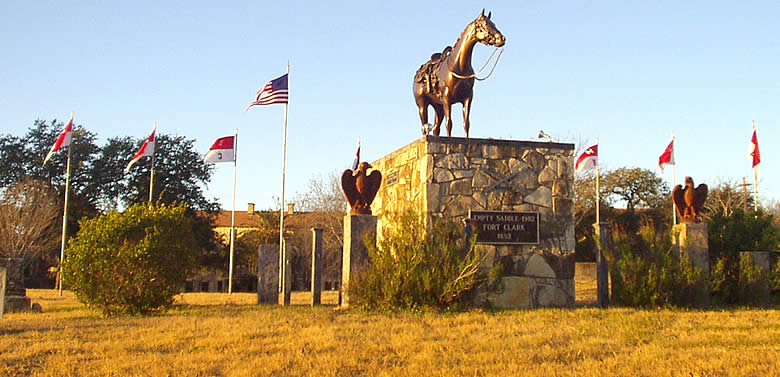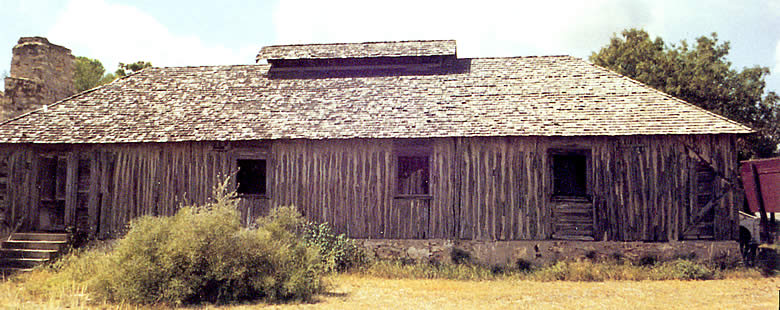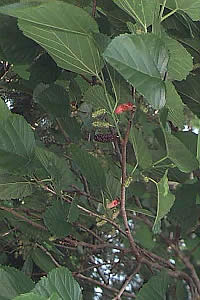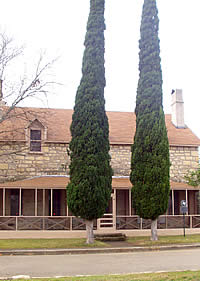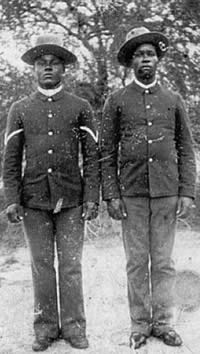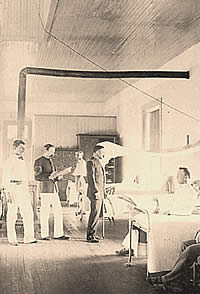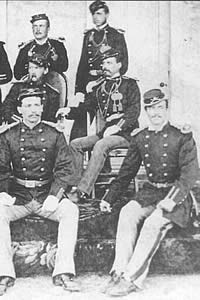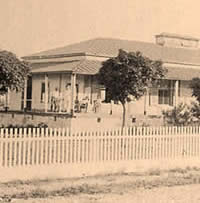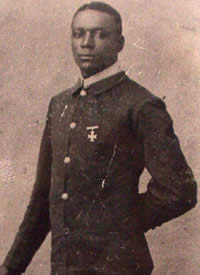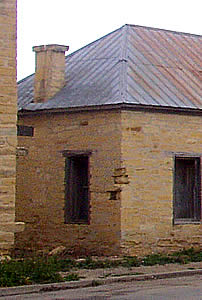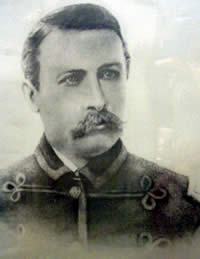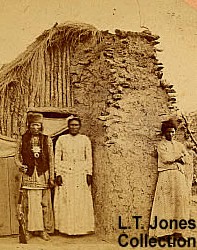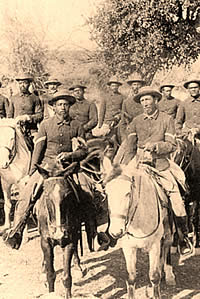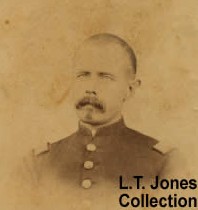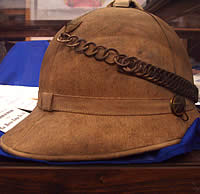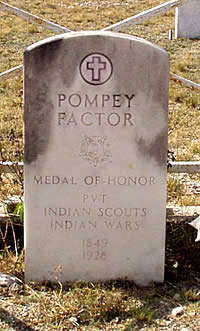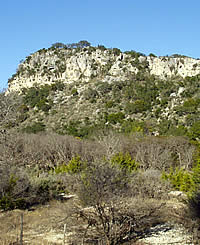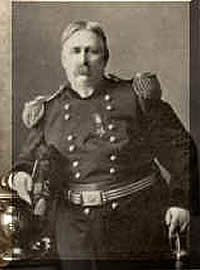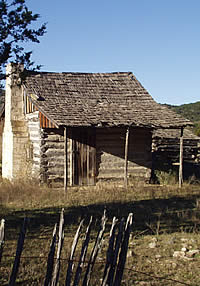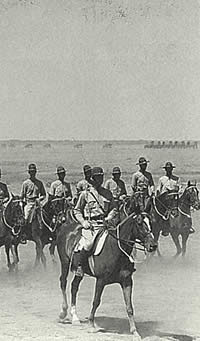
An "anachronism between two
world wars," troopers of the 5th Cavalry pass in
review, May 1939, Brig. Gen. Jonathan Wainwright commanding.
Detail of Ekmark photo. Click to see full image. Courtesy
Fort Clark Historical Society.
|
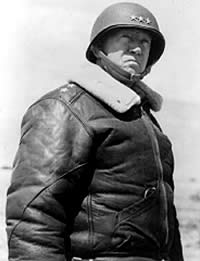
Gen. George S. Patton, Jr. The former
Fort Clark regimental commander died in France in 1945,
a year before the post closed. Photo by U. S. Army Signal
Corps, courtesy Library of Congress.
|
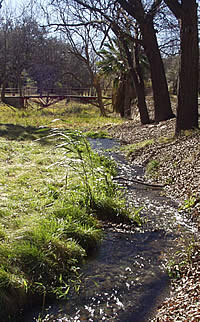
The clear waters of Las Moras springs
were a balm for Indian and Anglo travelers as well as
for the U.S. soldiers garrisoned at Fort Clark. Photo by Susan Dial.
|
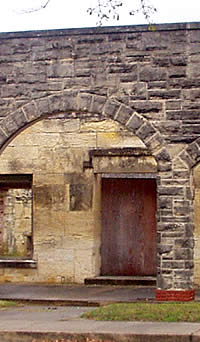
Hidden behind a burned-out façade,
the remains of post headquarters exemplify some of the
finest stone masonry at the fort. The construction date,
1857, can be seen dimly above the door. Photo by Susan Dial.
|
|
Long after the horse soldiers' time had passed,
Fort Clark was still a cavalry post. Wheeling in dusty drills
and negotiating narrow canyon trails, the troopers of the
5th Cavalry maintained the army's historical presence on the
Rio Grande. They were an anachronism between two world wars.
They also were heirs to a romantic tradition.
The regiment had originally been organized in 1855 as the
2nd Cavalry and led by Albert Sidney Johnston and Robert E.
Lee. By 1938, regimental commander George S. Patton Jr. stood
at the end of a line of officers distinguished by their dash
and daring. Patton died in France in 1945, one of the most
renowned field generals of the 20th Century. Fort Clark was
abandoned early the next year, a costly relic of American
frontier warfare.
Today, the traveler turning south off U.S. Highway
90 at Brackettville enters the residential community of Fort
Clark Springs, the remains of one of the U.S. Army's longest
occupations in Texas. Up the hill, a bronze statue stands
post above the clear waters of Las Moras Creek. It is a figure
reminiscent of the traditional ceremony acknowledging a fallen
comrade—the solitary horse, trooper's boots reversed
in the stirrups of an empty saddle.
Most of the fort's remaining 19th Century buildings
are in private use. Officers' quarters and enlisted men's
barracks—some dating from the 1850s—face the first
parade ground, now part of a par 3 golf course. The charred
remains of the old post headquarters still bear the date,
"1857," etched in the soft limestone blocks above
the original doorway. Down the hill and past the site of the
first commissary is one of the largest spring-fed swimming
pools in Texas, built in 1939 when General Jonathan Wainwright
commanded the post.
The springs of Las Moras—"the mulberries,"
in Spanish—probably attracted travelers for thousands
of years. By the late 1700s, the site was a stop on the eastern
branch of the Comanche trail from the southern High Plains
into Mexico. Perhaps because of the exposure to Indian raiders,
no Spanish or Mexican settlement took hold there.
Between 1830 and 1833, an English-born physician
named John Charles Beales secured about 50 million acres worth
of empresario contracts to settle 1,450 colonists on
lands north of the Rio Grande. Under the auspices of the Rio
Grande and Texas Land Company, Beales in 1833 began settling
Mexican and immigrant American, English, and German colonists
on the banks of Las Moras Creek a few miles downstream from
the springs. The settlement, named "Dolores," clung
to the poor soil for three years despite harsh climate and
Indian raids.
The beginning of the Texan revolt against Mexico
and the approach of Santa Anna's troops finally scattered
the settlers in 1836. One large wagon train en route to Matamoros
was attacked by Indians, and the colonists were massacred.
The village of Dolores was never reoccupied, although its
remnants became a rendezvous point for traders, trappers,
and other frontiersmen.
The first significant party of Anglo-Americans
to pass this way was led by U.S. Army lieutenants W.H.C. Whiting
and William F. Smith, returning to San Antonio after an expedition
to El Paso in 1849. Within a few months, a larger expedition
followed. Colonel Joseph E. Johnston, the army's senior topographical
engineer in Texas, was directed to mark a road westward from
San Antonio to El Paso, generally along the Whiting-Smith
route . Johnston was attached to a party of six companies
of the 3rd Infantry under Major Jefferson Van Horne. The expedition
included 275 wagons, 2,500 head of livestock, and a group
of emigrants on their way to California.
In 1852, the Army established a new chain of
forts to guard the western frontier of Texas settlements.
Major Joseph La Motte and two companies of the 1st Infantry
bivouacked at Las Moras Springs in June and named their camp
"Fort Riley." In July, the government leased the
land from San Antonio businessman Samuel Maverick for a term
of 20 years. That same month, the new post was named "Fort
Clark," in honor of Major John B. Clark of the 1st Infantry
who had died in the Mexican War.
The first temporary buildings constructed were
an adjutant's office, a bakery, and a guardhouse. The post
was inspected in 1853 by Colonel W. G. Freeman, who reported
that the troops were at work constructing quarters for themselves.
By the end of 1857, they had added a headquarters building,
hospital, and permanent bakery.
|
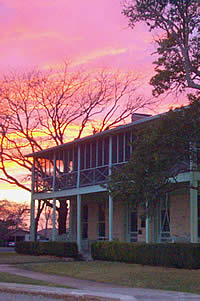
Sunset behind the Patton House. Built
in 1888, the wide, balconied Staff Officers Quarters
accommodated regimental commander George S. Patton during
the post's final years. The fort today is a privately
owned resort.
Photo by Susan Dial.
Click images to enlarge
|
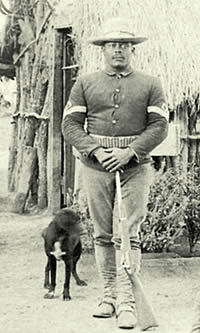
Sgt. Ben July, Seminole-Negro Indian
Scout, shown in late 1890s in front of jacal hut, Seminole
camp near Fort Clark. The famed scouts were a critical
factor in campaigns against Indians. Photo courtesy
Fort Clark Historical Society. Click to see full image.
|
|
Mulberry tree for which the springs,
Las Moras—the Mulberries—are named.
|
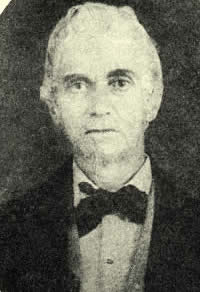
Samuel A. Maverick. The San Antonio
businessman leased land at Las Moras springs to the
U.S. government in 1852 for the establishment of Fort
Clark.
|
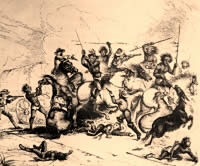
"Apache Indians Attacking Wagon
Train." Scenes such as this, drawn in 1854, illustrated
the dangers to immigrants on the southwest Texas frontier.
Image from Bartlett's Personal Narratives, courtesy
Texas State Library and Archives Commission.
|
|
